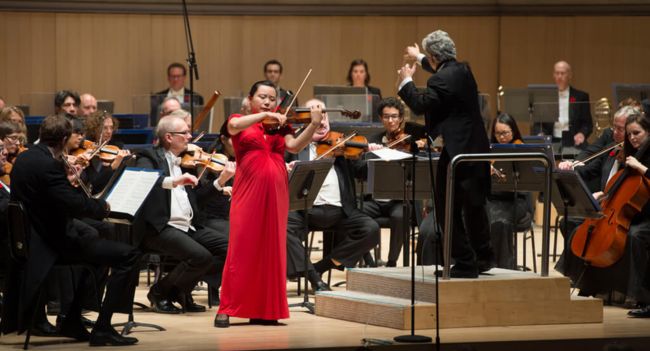
Please tell me about the Zanetto.
The instrument I mainly play was made by Peregrino di Zanetto around 1550—which makes it one of the oldest violas around. To put things into perspective, Bach was born 135 years later. The Los Angeles Philharmonic purchased this viola in 1964.
How did you come to play it?
When I started with the L.A. Phil in the summer of 2018, this instrument was made available for me to play. I didn’t start using the instrument right away, since it needed adjustments and it was a bit big for me. I needed to have some time to allow myself to familiarize comfortably with it.
What are its outstanding features?
Without my even trying, the sound is rich, warm, powerful, and has incredible depth. It doesn’t sound like a big violin, which sometimes is the character of violas. Its personality is noble, sonorous, and grandiose, yet it has various characteristics that make exploring possibilities of colors an incredible adventure. Sometimes I think of the Zanetto as my teacher. It advises me on how to move my body to produce the best sound possible.
When did you play it for the first time with the L.A. Phil?
It was in December of 2018; Maestro Zubin Mehta was conducting a Brahms cycle with a roster of superstar soloists. I was excited and nervous to work with a legend! At the first rehearsal break, I came onstage to go over a few passages. Maestro Mehta sat down at the podium, looked at me, and asked, “Where is the viola?”
I responded, “It’s at home—I plan to play it in January. It’s pretty big!” He laughed. We were rehearsing a Brahms symphony when, after a nice viola-section solo, he stopped the orchestra, turned toward me, and said, “It is very good, but I’d love to hear it with the other viola!” He turned to the violins and told them, “She said it’s at home!” At this point, the whole orchestra was laughing, not at me, but rather because of a certain familiarity with the maestro. There was a warm, tender feeling in the hall; it felt like someone at a family dinner complaining about not having his favorite dessert.
After a while, Maestro Mehta turned to me and said, “Really, all jokes aside, would you give it a chance?”
What did you do?
The next day, I brought the Zanetto. I have played Brahms’ music a lot and was able to adjust quickly. Maestro Mehta looked at the viola and me with such affection! The instrument sounded very rich and warm. It was the perfect instrument to play Brahms. I fell in love with it instantly. I learned later that day that Maestro Mehta hand carried the instrument back from Switzerland in 1964 when the L.A. Phil purchased it. During his music directorship, he helped the Philharmonic buy some fantastic stringed instruments to help build a world-class string sound.
And they are obviously still very much in use.
The instruments are still played by the members of the orchestra some 50 years later. The orchestra musicians know very well how much Maestro Mehta cares about the instruments he knows and bought. There is so much appreciation from all of us to him for creating the instrument bank at the L.A. Phil. I’ll remember and treasure this first experience of playing the Zanetto viola forever.
Is the size of the Zanetto still a challenge?
The Zanetto viola is quite big. How I played on a smaller instrument doesn’t apply. I find myself constantly adjusting my techniques to better play this instrument. It is more my limitations than the instrument’s.
Given the ability, what would your instrument say to you?
I can imagine him saying these phrases:
- “You do need to practice a little bit more on these passages. Don’t worry, we will get there.”
- “Maybe a different color there—you should explore what else I can do!”
- “You pushed too hard; I didn’t like it.”
In which of your core repertoire does it sound particularly fabulous?
A few months ago I was very fortunate to be featured in Strauss’ Don Quixote. It felt very good. All the various characteristics of Sancho Panza (the character the solo viola represents) I had envisioned came alive. According to some audience members, this incredible instrument made the viola heard very well!
You said the Zanetto is the instrument you “mainly play.” Are there others?
I also play a fantastic viola made in 2003 by Hiroshi Iizuka. Years ago, when I was a student at the Curtis Institute of Music, I would go see the Guarneri Quartet perform every year at the Philadelphia Chamber Music Society. I saw Mr. Iizuka often at these concerts. He was like a hero to many of us since he made Michael Tree’s viola. It was in 2004 when I first visited his workshop to borrow an instrument. It was like being in a candy shop! Every instrument sounded amazing in its own way, and it was hard to make a decision. He let me borrow an instrument longterm, and it was with that viola I won my first job at the Toronto Symphony Orchestra. Since then I have always had an Iizuka. His instruments are never disappointing. They are warm, sonorous, resonant, and each one has its own soul.
Teng Li’s Gear
Bows Eugène Sartory; C.J. Fonclause; Kaspar Pankow
Strings Thomastik-Infeld Solo Vision; Pirastro Passione; Larsen
Case Gewa Idea 2.8 Oblong Viola Suspension Case
Rosin William Salchow viola rosin; Baker’s rosin
Additional Gear Mach One maple viola shoulder res
